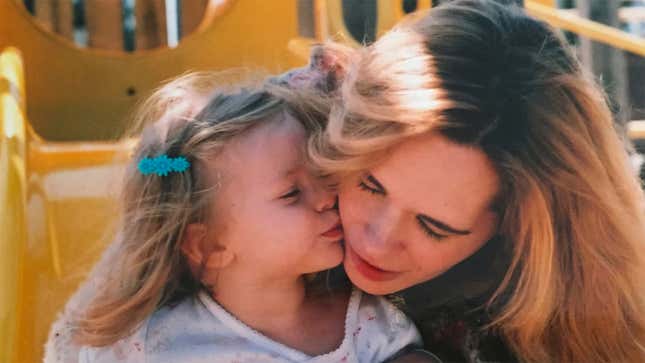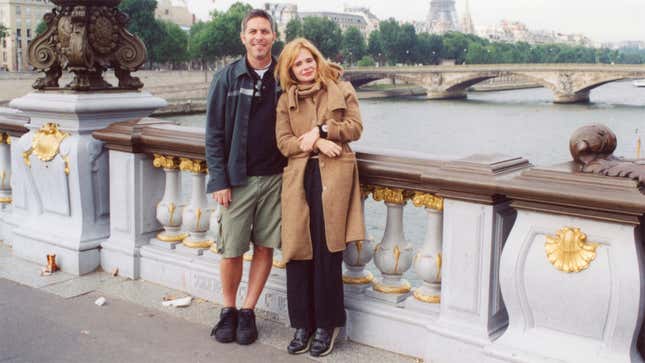Adrienne Shelly’s Husband Will Not Let You Forget About Her
The Waitress actress/writer/director, who was murdered in 2006, is the subject of a new HBO documentary directed by Andy Ostroy.
EntertainmentMovies

“I was living the worst nightmare imaginable,” says Andy Ostroy in the documentary he directed, Adrienne. He’s referring to the senseless murder of his wife Adrienne Shelly in 2006. By then, Shelly had established herself as an indie staple, a well-respected actor who was on the verge of a career breakthrough as an auteur. If you’re having a hard time placing her name or haven’t heard of her at all, you aren’t alone. Part of Ostroy’s objective in Adrienne is to pay proper public tribute to an overlooked life and career.
Shelly initially made a name for herself after performing in well-regarded movies during the indie boom of the late ‘80s/early ‘90s (including her debut, Hal Hartley’s 1989 film The Unbelievable Truth, and Hartley’s 1990 follow-up Trust). When she was killed, she had wrapped the movie that she would come to be best known for: Waitress, a vivid and compassionate comedy released posthumously in 2007, which was ultimately adapted into a long-running Broadway musical. Shelly wrote, directed, and starred in the movie.
There’s an early scene in Adrienne, which is now streaming on HBO, in which Ostroy polls people outside the Brooks Atkinson Theatre, where Waitress ran from 2016 to 2020. Despite Shelly’s name being on the marquee, it’s clear that the audience largely doesn’t know who she is. Ostroy’s doc, then, serves as a reminder of a life that was cut short. It features several of Shelly’s friends, family members, and colleagues, and tons of archival footage (culled from “hours and hours and hours” of tapes Shelly had left behind). It is not a true-crime doc, per se, but it does rather methodically take viewers through November 1, 2006, when Shelly was found hanging in the shower of her apartment. The police initially ruled her death suicide, but because Ostroy pressed (why would someone so happy, with a 2-year-old child, who had just produced the creative achievement of her career, kill herself?), the cops reexamined and eventually found a footprint in her bathtub belonging to Diego Pillco, who had been working in the building. Pillco eventually confessed to the crime and was sentenced to 25 years in prison.
Ostroy eventually met with Pillco on camera to get the full story of his wife’s murder. That’s in the doc, as is footage of Ostroy discussing Shelly’s life and death with their daughter Sophie, who is now 17. Adrienne is imbued with life and loss—it gives and takes, like life itself. For years, Ostroy has been publicly devoted to preserving Shelly’s legacy, having established the Adrienne Shelly Foundation for women filmmakers (it counts Chloe Zhao, who won the Best Director Academy Award this year for Nomadland, among its grant recipients). Adrienne is just the latest step in this endeavor. In a recent interview with Jezebel, Ostroy discussed the making of his movie, meeting with his wife’s murderer, and why he doesn’t believe in the concept of closure. An edited and condensed transcript of our conversation is below.
JEZEBEL: How long had this documentary idea been bubbling?
ANDY OSTROY: It goes back somewhere around three and a half, four years. The real trigger was when I took Adrienne’s mother to see the musical Waitress on Broadway. Before the curtain went up, she got to talking with a few women sitting behind us and eventually shared that Adrienne had something to do with this musical. And they were like, “Oh, that’s great. Is she here tonight?” That got me thinking, as I looked around the theater at well over a thousand people, how many of these people know who Adrienne is and the story of her life and her death. That’s when I decided, because Adrienne was a filmmaker and a storyteller, that if I’m going to tell this story, it seemed most fitting to honor her and pay tribute to her through film.
Early in the movie, you interview people outside the theater where Waitress is playing, and person after person doesn’t know who Adrienne is. It seems like preserving her legacy was key to you.
The film always had three components: life, death, and aftermath. In terms of what questions that I seek to answer through this film, the three main ones were: Who was Adrienne Shelly? What really happened the day she died? And how does her family navigate the unthinkable? So bringing her back to life for viewers, having them get to know her, fall in love with her, and then grieve her loss in a profound way and perhaps be inspired and motivated to go back into her catalog and check out her work they may not have seen before, that was the real motivator for me.
You framed Adrienne as the motivator here, and not your own experience. Has this process been cathartic for you? At the end of the movie you say, “I struggle with the concept of closure. My life will always be about grief.” Did this process bring you any closer to closure or is Adrienne’s death a perpetual void that you live with?
-

-

-

-

-

-

-

-

-

-

-

-

-

-

-

-

-

-

-

-

-

-

-

-

-

-

-

-

-

-

-

-

-

-

-

-

-

-

-

-









































